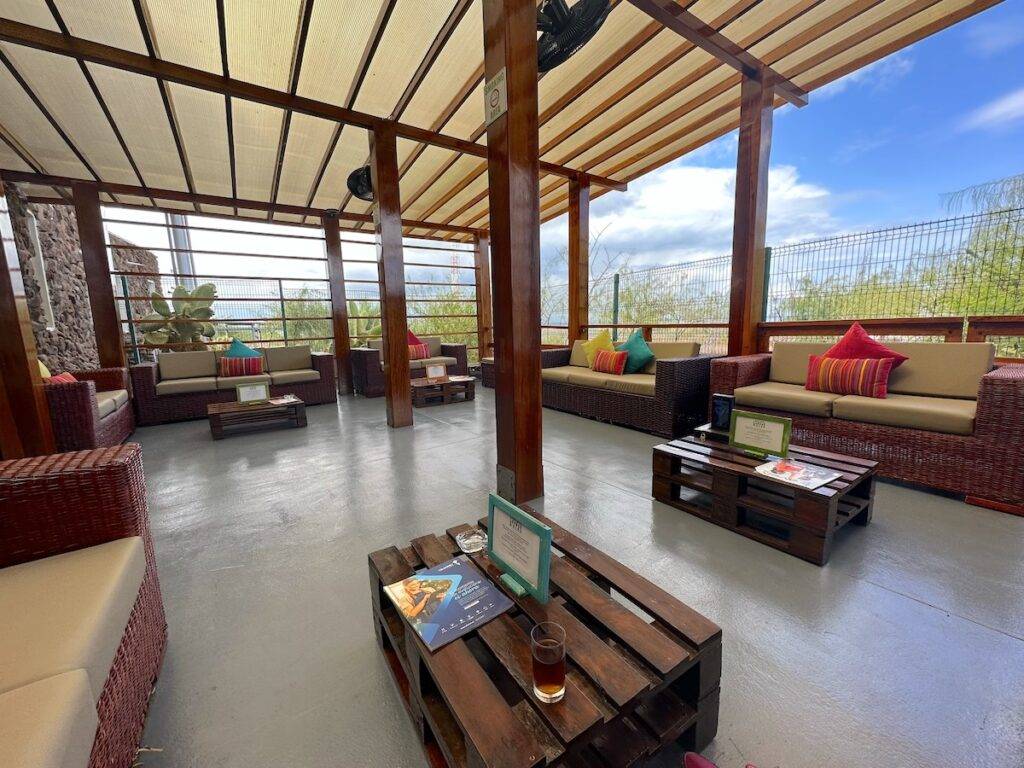Ecuador’s Seymour Airport, constructed of recycled materials and running on solar and wind energy, offers not just a place for planes to land and take off but a home for birds, lizards, and plants.
As I wait for my flight from the Galapagos back to mainland Ecuador, a huge land iguana comes trundling through the lounge. Minutes later, I’m swarmed by sparrows trying to eat my crackers. Welcome to the world’s first ecologically friendly airport. You won’t find frigid air conditioning and sealed walls here. Instead, you’ll enjoy outside air, high ceilings, eco-friendly materials, and stalls selling local handicrafts. Also sparrows. And iguanas.


The Seymour Airport, also known as Galapagos Ecological Airport, opened in 2012 after tourism had outgrown the previous smaller incarnation. It runs entirely on solar and wind energy, and 80% of its construction materials were recycled from the old airport, including steel tubes from earlier drilling operations in the Amazon. Reminders of its eco mission are everywhere, often featuring the airport’s cartoon mascot, a giant tortoise wearing a hat. The backs of chairs at the gate have bilingual signs explaining that the eco-friendly seats are made with FSC-certified wood — meaning that the Forest Stewardship Council has ensured that it comes from responsibly managed forests that provide environmental, social, and economic benefits. More signs tout the circular economy — reusing and regenerating materials — and explain the difficulties of transporting goods to these remote islands 600 miles off the coast of Ecuador. And, of course, there’s the wildlife. I’ve never seen so many birds and lizards in an airport.
“The main thing is that it’s a sustainable public building that can balance technology and comfort for passengers without polluting the environment,” said airport manager Jorge Rosillo. “That is basically the legacy we want to give.”
“The main thing is that it’s a sustainable public building that can balance technology and comfort for passengers without polluting the environment,” said airport manager Jorge Rosillo, as reported by Airport Technology. “That is basically the legacy we want to give.”
ECOGAL SA, which has a 15-year contract to run the airport, is part of the Argentine capital holding company Corporación América. The Luxembourg-based organization operates more than 50 airports in Latin America and Europe and is eyeing an Africa expansion. The Galapagos airport is Corporación América’s pilot greener airport project. Its success — it was designated LEED Gold Level (LEED stands for Leadership in Energy and Environmental Design) by the US Green Building Council, and in 2018 it became the first carbon-neutral airport in Latin America and the Caribbean — has spurred Corporación América to eco-friendlier practices around construction and carbon output at some of its other airports.
Americans built the original Baltra airport during World War Two. The US Air Force aimed to protect the Panama Canal, but the base had dire consequences on land iguanas. Already the lizards suffered from feral goats eroding their habitat and feral cats eating their hatchlings. Now they had bored soldiers using them for target practice. Large, slow-moving lizards are easy to hit. Soon after the war, land iguanas went extinct on Baltra.
One of Rosillo’s proudest achievements is collaborating with Parque Nacional to reforest Baltra and reintroduce land iguanas. “Working on this project is very satisfying, because you see the effects of your work almost directly,” he said in an interview with the Airport Carbon Accreditation website. “It’s sufficient to say that the yellow iguana is now back for good, and the native plants started thriving again.”
It’s always hard for an average citizen to know how much of an eco project is greenwashing and hype. But sitting in the outdoor area of the VIP lounge at the Galapagos Ecological Airport, I notice a cloud of dust flying up into the air. I put down my laptop and walk to the edge of the lounge, peering into the nearby dirt. Just a few feet from me, a big yellow land iguana is digging a burrow with its back claws, close to one of the delicious cacti it likes to eat. I can’t unravel the intricacies of carbon offset programs, but if this big lizard wants to call the Galapagos Ecological Airport home, I’ll take it as an endorsement.


